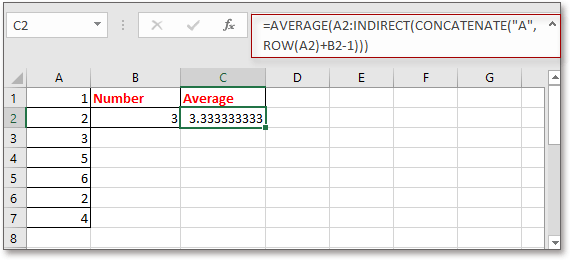Come definire un intervallo basato sul valore di un'altra cella in Excel?
Calcolare un intervallo di valori è facile per la maggior parte degli utenti di Excel, ma hai mai provato a calcolare un intervallo di valori basandoti sul numero presente in una cella specifica? Ad esempio, c'è una colonna di valori nella colonna A e voglio calcolare il numero di valori nella colonna A basandomi sul valore in B2, il che significa che se in B2 c'è 4, farò la media dei primi 4 valori nella colonna A come mostrato nello screenshot sottostante. Ora vi presento una formula semplice per definire rapidamente un intervallo basato sul valore di un'altra cella in Excel.
Definisci l'intervallo basato sul valore della cella
 Definisci l'intervallo basato sul valore della cella
Definisci l'intervallo basato sul valore della cella
Per eseguire un calcolo su un intervallo basato sul valore di un'altra cella, puoi utilizzare una formula semplice.
Seleziona una cella vuota dove vuoi ottenere il risultato, inserisci questa formula =MEDIA(A1:INDIRETTO(CONCATENA("A",B2))), e premi Invio per ottenere il risultato.
1. Nella formula, A1 è la prima cella nella colonna che desideri calcolare, A è la colonna su cui stai facendo il calcolo, B2 è la cella su cui ti basi per il calcolo. Puoi modificare questi riferimenti secondo necessità.
2. Se vuoi fare il totale, puoi usare questa formula =SOMMA(A1:INDIRETTO(CONCATENA("A",B2))).
3. Se il primo dato che vuoi definire non si trova nella prima riga di Excel, ad esempio, nella cella A2, puoi utilizzare la formula in questo modo: =MEDIA(A2:INDIRETTO(CONCATENA("A",RIF.RIGA(A2)+B2-1))).
Conta/Somma rapidamente le celle in base al colore di sfondo o formato in Excel |
In alcuni casi, potresti avere un intervallo di celle con diversi colori e ciò che vuoi fare è contare/sommare i valori in base allo stesso colore. Come puoi calcolarlo rapidamente? Con Kutools per Excel's Conta per colore, puoi eseguire rapidamente molti calcoli in base al colore e generare anche un report del risultato calcolato. Scarica Kutools e prova subito! |
Kutools per Excel - Potenzia Excel con oltre 300 strumenti essenziali. Goditi funzionalità AI gratuite per sempre! Ottienilo ora |
I migliori strumenti per la produttività in Office
Potenzia le tue competenze in Excel con Kutools per Excel e sperimenta un'efficienza mai vista prima. Kutools per Excel offre oltre300 funzionalità avanzate per aumentare la produttività e farti risparmiare tempo. Clicca qui per ottenere la funzione di cui hai più bisogno...
Office Tab porta le schede su Office e rende il tuo lavoro molto più semplice
- Abilita la modifica e lettura a schede in Word, Excel, PowerPoint, Publisher, Access, Visio e Project.
- Apri e crea più documenti in nuove schede della stessa finestra invece che in nuove finestre.
- Aumenta la produttività del50% e riduce centinaia di clic del mouse ogni giorno!
Tutti gli add-in Kutools. Un solo programma di installazione
La suite Kutools for Office include add-in per Excel, Word, Outlook & PowerPoint più Office Tab Pro, ideale per i team che lavorano su più app di Office.
- Suite tutto-in-uno — Add-in per Excel, Word, Outlook & PowerPoint + Office Tab Pro
- Un solo programma di installazione, una sola licenza — configurazione in pochi minuti (pronto per MSI)
- Funzionano meglio insieme — produttività ottimizzata su tutte le app Office
- Prova completa30 giorni — nessuna registrazione, nessuna carta di credito
- Massimo risparmio — costa meno rispetto all’acquisto singolo degli add-in